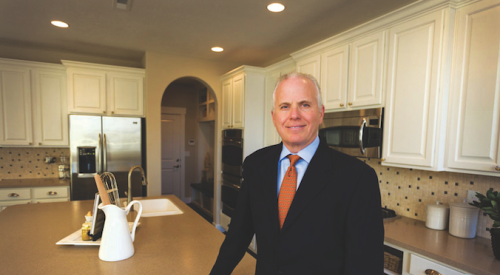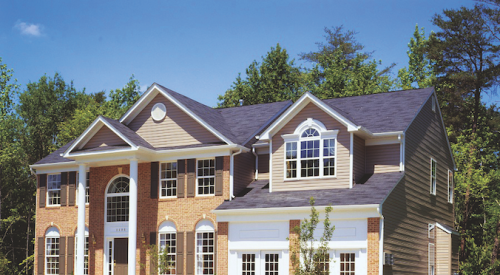When the New York Stock Exchange began the trading day on April 10, a home builder rang the opening bell. An honor reserved primarily for companies going public, this scene was unthinkable at any point over the past eight years. During the final stages of the housing bubble (2005 to 2007), investors were not buying shares in building stocks. After the bubble burst in 2007, investors waited through 2012 for the market to hit bottom before returning to housing stocks. For Sheryl Palmer, CEO of Taylor Morrison Homes—No. 9 on the 2013 list of Housing Giants—and the rest of the company’s leadership team, going public this spring was a satisfying culmination of years spent planning and preparing.
Taylor Morrison’s Road Ahead
Q&A with Sheryl Palmer, CEO
For Taylor Morrison CEO Sheryl Palmer, the April 10, 2013, initial public offering of company stock was a culmination of work that began in May 2006 when she accepted the CEO position of Morrison Homes. Previously, she had been a regional president for PulteGroup Inc., having started her career with Del Webb, which was acquired by Pulte Homes in 2000. Morrison Homes and Taylor Woodrow began merger talks soon after Palmer’s arrival and a deal was reached in July 2007.
According to Palmer, the housing bust, in hindsight, gave the new company time to merge, regroup, and set on a new course. “We had a builder in Morrison Homes and we had a developer in Taylor Woodrow,” says Palmer. “It was about combining those two skills. It was about people, the land bank, and the ability to compete better.”
Like most builders, Taylor Morrison had to trim its organization to match the downturn. In 2009 and 2010, the company avoided paying high prices for finished lots and instead bought large parcels in Arizona and Austin, Texas, to entitle in-house. Those lots are just now coming to market, says Palmer.
PB: What was the rationale for Taylor Morrison to go public?
Sheryl Palmer: It was the perfect time for Taylor Morrison to complete an IPO. We’re seeing strength across all of our markets. We have a strategic and diversified footprint and we are poised to take advantage of favorable trends in the housing market.
PB: Operationally, have you implemented any new ideas to turn your homes around faster?
SP: 2012 was a strong year for us, with a 39-percent increase in homebuilding revenues and a 46-percent increase in new orders. 2012 backlog increased 176 percent year-over-year; this is tangible evidence of the current strength of the home building industry.
PB: Who’s buying your product these days?
SP: We are seeing all buyer groups pursue home ownership with the greatest group in the recovery being recognized in the move-up buyer and the older adults. Our business is distinguished by our expertise in delivering lifestyle communities targeted at move-up buyers. Taylor Morrison is well positioned with our business mix diversified across markets, regions, customers, and price points.
PB: Are you coming to the market with new product?
SP: We spend considerable time understanding the wants and needs of our customers, and design our communities around those preferences and are constantly trying to align our projects with homebuyer demand. As such, we already build and sell a broad mix of homes in all of our markets across diverse price points.
PB: Are you moving into any new locations? If so, where?
SP: We carefully consider all opportunities to enter new markets, although we’re very happy with our current footprint. We are seeing strength across all of our markets, we have a strategic and diversified footprint, and we are poised to take advantage of favorable industry trends in the housing market.
PB: What are your square footages?
SP: We have a broad range of square footages starting with 400 sq. ft. studio units in our Canadian high rises, to 5,000-plus sq. ft. homes in the U.S.
PB: Are you buying land? If so, where?
SP: We have significant land inventory, representing approximately 10.7 years of land supply, carried at a low cost basis that will more effectively enable us to execute our growth-focused business plan.
The journey started several years ago when the strategic merger between Taylor Woodrow and Morrison Homes created the Phoenix, Ariz.,-based Giant. That union was followed by the arduous process of right-sizing the organization and top-grading its executive ranks. When overheated demand for finished lots caused prices to skyrocket, Taylor Morrison managers bypassed that market and opted instead to put sweat equity into developing raw land. The builder waited still more years for its next merger opportunity and last December acquired a premier builder in the nation’s hottest housing market—Texas.
All of these developments ultimately led to Taylor Morrison’s successful $500 million initial public offering in April. Since that day, Taylor Morrison’s stock price, ticker symbol TMHC, rose steadily from $22 per share when the bell first rang, to $25.78 per share when this magazine went to press April 30.
The company’s value to investors stems directly from its business accomplishments in 2012. Through organic and acquisition growth, Taylor Morrison’s revenue increased 95.6 percent to $1.37 billion, up from $700 million a year earlier. Closings in its five-state service area increased to 4,014, up from 2,327. These figures include full-year numbers amassed by Darling Homes, a Frisco, Texas-based company that was the industry’s No. 43 builder until Taylor Morrison purchased it in December 2012. Taylor Morrison is not alone in its dynamic growth or desire to raise capital through the public markets. But it can certainly be seen as a standard bearer for this year’s class of Housing Giants. See our sidebar on page 22.
Like Taylor Morrison, many other builders experienced similar growth and a few went public. Among them are UCP (Union Community Partners), which operates Benchmark Homes, and the venerable Southern California builder William Lyon Homes, which expects to go public this spring. After years in the wilderness, big builders are once again hot properties among investors. The overall numbers from this year’s Housing Giants help explain why. Revenue for the top 225 Giants increased 26.5 percent to $53.5 billion, up from $42.3 billion posted in 2011. In terms of closings, the top 225 tallied 207,907, up 20.4 percent from last year’s 172,750. But the real story can be told in terms of market share gains made by Giants versus non-Giants.
The big get bigger
According to Commerce Department figures, 649,200 homes were completed in 2012, up 10.9 percent from 584,900 in 2011. That same year the top 225 Housing Giants accounted for 29.5 percent of all completions. Despite the fairly robust growth in the overall size of the market, the Giants’ share of completions last year grew to nearly a third of the market, at 32 percent. But these figures do not begin to tell the story of an industry whose current growth derives primarily from the very top of the industry.
Giants ranked Nos. 1 through 20 accounted for 18.2 percent of the closings in 2012, up 1.4 share points from 2011. Giants ranked Nos. 21 to 75 gained a share point, grabbing 8.5 percent of the market in 2012, while share gain among Nos. 76 to 150 grew only 0.2 points. Those ranked 151 to 225 actually gave ground (0.1 share point) to their larger brethren. In fact, the long-awaited recovery is playing out exactly as the industry’s Giants had expected. They recovered quickly and are in a position to continue grabbing more market share as the industry resumes its march toward the historical equilibrium of 1.6 million new single-family and multifamily homes per year.
Why did the biggest home builders grow rapidly in 2012, and why will they continue to do so? They are not facing the same obstacles the rest of the industry is enduring, such as trying to access financing to build, sourcing finished lots in good locations, and navigating mortgage-underwriting standards that leave many new-home buyers on the sidelines. The biggest builders have an extremely low cost of capital and plenty of it. They also developed and now carry a good supply of high-quality finished lots. Additionally, many (certainly not all) of the largest builders have in-house mortgage divisions or close relationships with banks that help their customers get to the closing table faster.
A new order: Horton No. 1
Methodology
Professional Builder has been compiling its list of Housing Giants for more than 40 years. Firms that wish to apply for the list must complete a questionnaire. In addition, Professional Builder retains the services of researchers who contact large building firms who have not volunteered information in order to cast the widest net for the biggest home-building firms. The rankings are based on new-home revenue only. Firms with less than 30 starts cannot be included in the ranking. To learn more or to inquire about applying for next year’s list, please contact Professional Builder’s awards coordinator Heidi Riedl at hriedl@sgcmail.com or (847) 391-1000.
For several years the question of which firm owned the top spot was a split decision. Previously, PulteGroup Inc., retained the industry’s top spot in terms of revenue from new-home sales, while D.R. Horton Inc., claimed the top slot in terms of the number of closings. This year there is no split decision. D.R. Horton is the nation’s No. 1 home builder in new-home revenue ($4.56 billion) and closings (19,954). In 2012, the company posted a 24.3 percent gain over the previous year. With a base of operations in Texas and regional strength across the booming Sunbelt, Horton was in a better position to benefit from the 2012 market recovery than its Michigan-based rival.
For its part, PulteGroup has taken a different strategy. Instead of focusing on volume growth, it pursued operational efficiencies and margin growth. According to Zelman & Associates, PulteGroup’s margins are the strongest among large publicly traded builders, which is the main reason why its stock price appreciated 200 percent since the beginning of 2012. That said, the company managed to grow its new-home revenues by 15.2 percent in 2012 and increase its units closed to 16,505, up from 15,275 a year prior. Over the long term, the company’s leaner focus should keep it in good stead as the market moves toward a fuller recovery.
Like PulteGroup, NVR Inc., the No. 4 home builder in the U.S., saw 2012 growth limited by its long-held strategy of optioning land rather than owning it. NVR’s revenues grew by 19.5 percent in 2012 and are widely expected to exceed that pace this year. The nation’s No. 3 builder, Miami-based Lennar Corp., increased sales by 33 percent to $3.49 billion while adding more than 3,000 closings. The top four Housing Giants pursued different strategies with varying regional strengths and, barring further mergers, all four appear to have a tight grip on the top of the list for the foreseeable future.

















